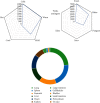A Data Mining-Based Analysis of Core Herbs on Different Patterns (Zheng) of Non-Small Cell Lung Cancer
- PMID: 34257676
- PMCID: PMC8257336
- DOI: 10.1155/2021/3621677
A Data Mining-Based Analysis of Core Herbs on Different Patterns (Zheng) of Non-Small Cell Lung Cancer
Abstract
Objective: To explore the role of Chinese prescriptions in non-small cell lung cancer (NSCLC) and provide references for the application of herbs and prescriptions.
Methods: Randomized and quasirandomized controlled clinical trials on Chinese herbal medicine in the treatment of NSCLC were collected from seven databases to establish a database of prescriptions on NSCLC. Data-mining analyses were performed by RStudio (v4.0.3) software.
Results: A total of 970 prescriptions were obtained from 945 included studies, involving 7 syndromes and 428 herbs. The main patterns of NSCLC included qi deficiency pattern, yin deficiency pattern, blood deficiency pattern, kidney deficiency pattern, heat toxin pattern, phlegm-dampness pattern, and blood stasis pattern. High-frequency herbs on NSCLC were Astragali Radix (Huangqi), Atractylodis Macrocephalae Rhizome (Baizhu), Glycyrrhizae Radix Rhizome (Gancao), Poria (Fuling), Ophiopogonis Radix (Maidong), Hedyotidis Diffusae Herba (Baihuasheshecao), Codonopsis Radix (Dangshen), and Glehniae Radix (Beishashen). The properties of the herbs were mainly cold, warm, and mild. The flavors of the herbs were mainly sweet, bitter, and pungent. The main meridian tropisms were Lung Meridian of Hand-Taiyin, Spleen Meridian of Foot-Taiyin, and Stomach Meridian of Foot-Yangming.
Conclusion: Applying clearing and tonifying method by targeting the lung and spleen was the most frequently used therapy in the treatment of NSCLC. This study offered a glimpse of unique views of traditional Chinese medicine on NSCLC and may benefit the treatment of NSCLC.
Copyright © 2021 Xiangjun Qi et al.
Conflict of interest statement
The authors report no conflicts of interest regarding the publication of this work.
Figures





References
-
- Travis W. D., Brambilla E., Nicholson A. G., et al. The 2015 World Health organization classification of lung tumors: impact of genetic, clinical and radiologic advances since the 2004 classification. Journal of Thoracic Oncology. 2015;10(9):1243–1260. doi: 10.1097/JTO.0000000000000630. - DOI - PubMed
-
- Yang J., Zhu X., Yuan P., Liu J., Wang B., Wang G. Efficacy of traditional Chinese Medicine combined with chemotherapy in patients with non-small cell lung cancer (NSCLC): a meta-analysis of randomized clinical trials. Support Care Cancer. 2020;28(8):3571–3579. doi: 10.1007/s00520-020-05433-w. - DOI - PubMed
LinkOut - more resources
Full Text Sources

